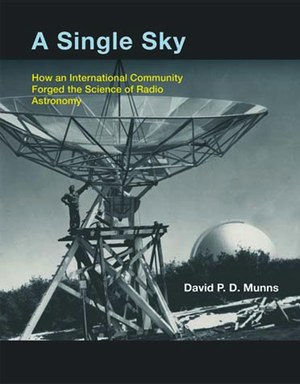Review: A Single Skyby Jeff Foust
|
| Notably, it was not conventional optical astronomers leading the way in radio astronomy so much as physicists who had worked on radar technologies during the war and were now seeking new applications for their work. |
Such cooperation, though, is hardly novel in the field of radio astronomy. (ALMA, technically speaking, operates at slightly shorter wavelengths than what is normally considered radio astronomy, but shares many other attributes with it.) Since the field’s origins in the mid 20th century, astronomers around the world worked closely together to develop radio telescopes and share scientific and technical insights, historian David P.D. Munns notes in his recent book A Single Sky. This cooperation across borders helped create a community, and ultimately, a new scientific discipline.
While Karl Jansky made the first radio observations of the sky in the early 1930s, detecting by accident radio emissions from the Milky Way, the field of radio astronomy didn’t start in earnest until after the end of World War II. Notably, it was not conventional optical astronomers leading the way so much as physicists who had worked on radar technologies during the war and were now seeking new applications for their work. In many cases, astronomy was not their first choice: in Australia, for example, physicists initially planned to work on linear accelerators, only to withdraw when they found they would not be able to keep up with the massive investments Americans were making in the field.
Radio astronomy, on the other hand, was new enough that modest investments could make real progress. Radio astronomy did not have the sensitivities of nuclear research, making international cooperation more feasible. The field also developed at a time when astronomy in general was struggling to attract students and retain researchers given the increased demand, and money, in competing fields like nuclear physics and electronics. While some astronomers treated the new field of radio astronomy skeptically—Australian astronomer Richard Woolley, asked in the late 1940s where radio astronomy would be in ten years, replied, “It will be forgotten”—other embraced it, welcoming the physicists into their fold. Nomenclature demonstrates this: by the 1950s, “radio physics” had become “radio astronomy,” with the antennas it used called “telescopes” and located at “observatories,” like their optical counterparts, even though many early practitioners of radio astronomy had little experience or even formal training in astronomy.
Munns argues in A Single Sky that radio astronomy was an exception to the competitive nature of most other realms of science. “The radio astronomers understood science as an open, inclusive, international, interdisciplinary process, and their community succeeded because of cooperation,” he writes. Throughout the book, he cites such examples of cooperation among American, Australian, British, and Dutch pioneers, ranging from the exchange of scientific and technical data to frequent visits by astronomers to one another’s facilities.
Yet, even Munns acknowledges that early radio astronomy was not an entirely “edenic open community.” Competition played a role as well, both across national boundaries and within nations. Plans for a radio telescope at England’s Jodrell Bank were supported in part on the giant dish being “a symbol of national leadership” in an emerging field, one that could be more capable than the optical telescopes dominated by the US. Within Britain there was competition as well: Bernard Lovell, who led the development of the Jodrell Bank observatory, sparred with Cambridge’s Martin Ryle, who eschewed giant parabolic antennas in favor of linear arrays of antennas. “The giant parabola offended the Cavendish tradition through waste, extravagance, and inefficiency,” Munns writes.
| “The radio astronomers understood science as an open, inclusive, international, interdisciplinary process, and their community succeeded because of cooperation,” Munn writes. |
One question unanswered by the book is just how different this spirit of cooperation in radio astronomy is from other branches of astronomy or other sciences, for that matter. Munns plays up the various exchanges of information among early radio astronomers, from the sharing of data to helping find postdoc positions for students completing their doctorates. Yet, such collaboration does not seem foreign to astronomy today, where researchers frequently work together (and, of course, sometimes compete against one another.) Did early radio astronomy’s cooperative spirit infect astronomy as a whole, or did it already exist?
For those looking for a history of the science of radio astronomy, A Single Sky is not the best choice: Munns doesn’t delve into the science beyond what’s needed to explain the early developments of this field. Instead, this book is a history of the development of radio astronomy as a scientific discipline, one that involved collaboration, particularly on international scales, far more than competition. While the unique role of cooperation in radio astronomy might be overplayed a bit in the book, it’s clear that collaboration is here to stay, as the desires of astronomers for bigger and better telescopes, like ALMA, reach scales beyond the ability or willingness of a single institution, or even a single nation, to support them.
